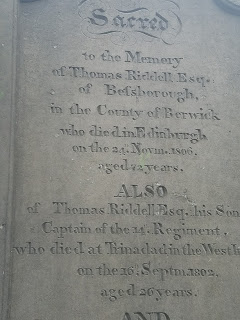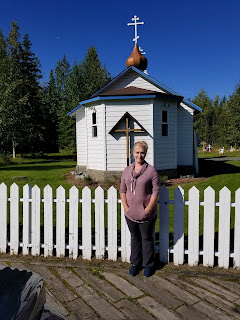Greyfriars Kirkyard
Those of you who know me well know that I spend a great deal
of time wandering around old cemeteries. I love them; I find them to be
peaceful and strangely beautiful. On our recent trip to Edinburgh we took a
nighttime tour of Greyfriars Kirkyard, we enjoyed it so much we decided to go
back the next day and spend the afternoon there.
Greyfriars Kirkyad began being used as a burial ground in
1562 when Mary Queen of Scots granted the former gardens surrounds Greyfriars
Kirk to be used as a burial ground. Prior to there was a small graveyard
surrounding St Giles, however this area had filled up and instead of being
buried side by side bodies were soon being stacked on top of each other, it did
not take long for bodies in these shallow graves to find their way above ground.
Many bodies were moved to the new graveyard and placed in unmarked graves,
leaving this cemetery with many more bodies than there are markers, it is
likely that at any point you may be stepping on someone’s unmarked grave.
 |
| Flooden Wall |
As you walk through this graveyard, you will notice that
grave monuments and tenement buildings are back to back with windows literally
opening up into gravesites. The monuments to these long gone people are indeed
works of art with elaborate carvings and stonework placed among walkways that
remind visitors that this area was once a beautiful garden and is still a
lovely place to walk about and enjoy an afternoon. In a corner of the kirkyard you see a remaining piece of the Flooden Wall, built after the Scots were heavily defeated by the English at the Battle of Flooden 1513. This wall was built as a form of protection for the old medieval town.
Inside Greyfriars Kirkyard lies Covenanters Prison, in 1679
this area was used to hold men who had supported the National Covenant. These
men were housed in an area with no shelter for months being given only a
minimal amount of bread to survive on, many died, some gave in and signed
loyalty to the king, while others were transported to the colonies to work as
indentured slave laborers and still more were executed with their heads
displayed on gate posts. All of this is
yet another example of the horrible things we have done in the name of
religion.
Sir George Mackenzie
earned the name of the Bloody Mackenzie when he became the minister responsible
for enforcing King Charles policies against the Presbyterian Covenanters. He imprisoned
the men in Covenanters Prison, tortured them, starved them, and executed some
all while carrying on the façade of loving husband and father. He hid his
actions so well it is said his wife had no idea he had such a vicious side to
him. Mackenzie is responsible for 18,000 deaths in pursuit of a unified
religion for Scotland. This period of time is referred to as the “Killing Time”.
George Mackenzie died in 1691 and his remains now lay in the
Black Mausoleum tomb at Greyfriar's Kirkyard. In 1999 a homeless man seeking
shelter made his way into the Black Mausoleum and fell through the floor, since
that time hundreds of reports of poltergeist activities from around the tomb
have been reported. Some believe that this action “woke” the Bloody Mackenzie
up and he has been terrorizing visitors ever since then. Visitors report
feeling faint, difficulty breathing, and some even report marks left on them
after visiting his mausoleum.
 |
| The Black Mausoleum |
Walking along the graveyard, you can also see mortsafes,
iron bars that covered graves in order to deter grave robbers who would sneak
in at night, exhume newly deceased bodies, and sell them to the local medical
school.
In the early 19th century Edinburgh was home to
the leading school on anatomical studies, because of this the school was in
need of corpses to dissect and study. Bodies came from convicted criminals who
had been executed or those who died in prison, however there soon became a
shortage of corpses. Along came Burke and Hare, two men who began to kill
homeless people by enticing them to their lodging house, giving them food and
alcohol until they passed out and suffocating them in a way that was not easily
detected. They would then sell the bodies to the medical school. These two men
where finally arrested and because of lack of evidence against them an offer
was given to Hare to turn Kings evidence against Burke. Burke was found guilty and
sentenced to death; his body was hung and then given to the very medical school
he had provided with his 16 innocent victims. His skeleton can still be seen
there today. Hare went free as a result
of his testimony against his partner.
 |
| Greyfriars Bobby memorial |
Finally Greyfriars Bobby the Skye terrier who Disney made a
movie about is buried here. The only pet to be placed in the graveyard, Bobby
was the loyal pet of John Gray who was a night watchman in Edinburgh in the
1800’s. Bobby went along with John on his nightly rounds to keep his master
company, after John died in 1858 it is said that Bobby visited his grave
nightly watching over and refusing to leave each night until his own death in
1872. In 1867 a law had been passed that said all dogs must be licensed or
destroyed. Sir William Chambers decided to pay for Bobby’s license and
presented him with a collar that read “Greyfriars Bobby”, this tag can be seen
at the Edinburgh museum. While Bobby was
taken care of by many citizens of Edinburgh, he remained loyal to his master.
Today people come, bring treats and gifts to Bobby’s grave, once a week these
are gathered up, and donated to a local shelter.









Comments
Post a Comment